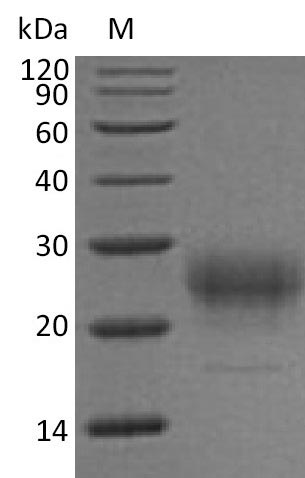Recombinant Mouse Interleukin-7 (Il7) comes from a mammalian cell expression system, which appears to ensure proper protein folding and post-translational modifications. The protein represents the full-length mature form spanning amino acids 26-154, with a C-terminal 6xHis-tag added for easier purification. Purity exceeds 95% based on SDS-PAGE analysis, while endotoxin levels stay below 1.0 EU/µg. Biological activity gets confirmed through an ED50 range of 60-1000 pg/ml in cell proliferation assays using PHA-activated human peripheral blood lymphocytes.
Interleukin-7 stands out as a key cytokine that regulates lymphocyte development and homeostasis. This molecule plays a central role in T cell proliferation and survival, and it may also influence B cell development. Through the interleukin-7 receptor signaling pathway, it likely helps maintain immune system function. For researchers studying immune cell development and function, this protein offers a valuable experimental tool.
Potential Applications
Note: The applications listed below are based on what we know about this protein's biological functions, published research, and experience from experts in the field. However, we haven't fully tested all of these applications ourselves yet. We'd recommend running some preliminary tests first to make sure they work for your specific research goals.
1. T Cell and B Cell Proliferation Assays
This recombinant mouse IL-7 is confirmed to be highly bioactive (ED₅₀ 60-1000 pg/ml in human PBL) and suitable for lymphocyte proliferation studies. However, the wide ED₅₀ range suggests variable potency across different lymphocyte subsets. While mammalian expression ensures proper folding and glycosylation, researchers should validate activity in mouse primary lymphocytes to confirm species-specific reactivity, as the activity data comes from human cells and may not reflect optimal mouse lymphocyte responses. The C-terminal His-tag is unlikely to significantly impact proliferation readouts.
2. Cytokine Receptor Binding Studies
The protein is appropriate for IL-7Rα binding studies, but the C-terminal His-tag may cause minor steric effects near the receptor-binding interface. While mammalian glycosylation supports authentic interactions, researchers should validate binding kinetics with tag-free IL-7 for precise measurements. The wide ED₅₀ range may reflect variable receptor affinity across different cell types, requiring careful dose optimization in binding assays.
3. Antibody Development and Validation
This mammalian-expressed IL-7 serves as an excellent antigen due to proper folding and glycosylation. However, the C-terminal His-tag may induce tag-specific antibodies, reducing antibodies against native C-terminal epitopes. Comprehensive validation should include testing against tag-free IL-7 to ensure recognition of physiological forms. The confirmed cross-species bioactivity supports the development of function-blocking antibodies.
4. Comparative Species Cross-Reactivity Studies
The demonstrated human cell activity enables valid cross-species comparisons, but the wide ED₅₀ range complicates direct potency comparisons. Researchers should perform parallel assays with human IL-7 in the same experimental systems to properly interpret species-specific differences. The mammalian expression ensures proper glycosylation patterns important for cross-species reactivity studies.
5. Protein Structure-Function Analysis
The full-length mature IL-7 (26-154aa) is suitable for structural studies, but the C-terminal His-tag may impede crystallization or affect biophysical measurements. For precise structure-function relationships, tag cleavage is recommended. The mammalian glycosylation ensures native-like structure, but the tag may alter conformational dynamics in some assays.
Final Recommendation & Action Plan
This mammalian-expressed mouse IL-7 with C-terminal His-tag is a high-quality reagent with demonstrated cross-species bioactivity, but the wide ED₅₀ range (60-1000 pg/ml) requires careful experimental design. For immediate use, first establish precise dose-response curves in your specific lymphocyte populations, as different T cell and B cell subsets may exhibit varying sensitivity to IL-7 stimulation. The mammalian expression ensures proper glycosylation, which is critical for IL-7's stability and function, but the C-terminal tag may cause minor steric effects in binding studies - consider tag cleavage for precise kinetic measurements. When developing antibodies, this protein is ideal due to native-like folding, but validate against tag-free IL-7 to avoid tag-specific responses. For cross-species studies, include both mouse and human IL-7 tested in parallel to account for assay variability. The low endotoxin is particularly valuable for primary human lymphocyte cultures. Always include appropriate controls (e.g., vehicle, tag-only) and consider that IL-7 responsiveness varies significantly between naive and memory T cell subsets, requiring population-specific optimization.






